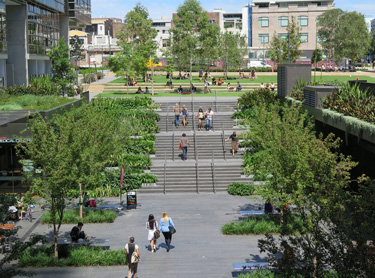Measuring the impact of greening benefits
For a while now we’ve been talking about the benefits of plants and green spaces, but how can we actually measure these benefits? Daniel Bennett, Vice President if the Australia institute of Architects explains…
We can measure greening benefits, through quantitative and qualitative measures, such as:
- total number of shade hours in summer
- solar penetration in winter, access to light for heating and passive heating
- percentage heat reduction to pavements and buildings in summer
- heating benefits in winter
- connected shade (length) on our streets
- reduction of stormwater drainage (i.e. smaller pipes)
- reduced runoff into our creeks and rivers
- ‘point source’ gross pollutant control (i.e. capturing rubbish at the source)
- improved air quality
- reduced reliance on air conditioning
- number of operable windows
- improved economic outcomes (increased trade or retail opportunities)
- improved walkability/cyclability
- improved property values
- improved amenity (the happiness factor); and
- desirability (the ‘hip’ factor, measured through engagement with people).
These measures are just for the street trees (see Kiwi Gardener issue 395) the same and more can be measured for green roof (issue 383) and green wall initiatives, not to mention other carbon abatement schemes.
Many houses may have west-facing walls, for example. A simple vine planted to climb the wall can reduce the internal temperature by up to 10 degrees on a hot day, and conversely in winter can assist in passively heating the house if the vine is deciduous.
We currently plant trees in streets based on available space. We must trial new methods including how many trees we plant within a given area, challenging where feasible the distances to services, as well as investing more in research for more suitable species. Detecting damage to our city’s infrastructure should also include damage and insurance for large trees, not just the physical services.
These are pragmatic, achievable, workable, negotiable, and measurable outcomes. We can do most of these now. We can measure them now. It need not require significant additional investment; it requires some adjustments on current expenditure to ensure taxpayers money is spent wisely and with real, measurable (including environmental) outcomes beyond just assessing elements such as ‘asset class,’ ‘depreciation’ and ‘insurance value.’
If we are to retain our valued parks, reserves and gardens and preserve them without adjusting their environmental performance (i.e. to protect them as they are), we need to adjust, refocus and change our management practices, approaches, risk management, maintenance and public perception approach to greening our city’s streets and squares to do more of the ‘heavy lifting’ in combating the effects of climate change.
This is not a question of environmental values over economic and social values. It is one of addressing an imbalance and asking ourselves how we can best adapt now to reflect the inevitable changes.
It is real, it is here, and we can do something about it. It needs to start now. We can all do our bit without too much fanfare, and when we do, we can all reap the benefits. And we can preserve our existing open spaces the way they are and enjoy them for what we like, whilst the City can perform the role of a climate-adapted and carbon neutral city. The choice is before us.
Written by Daniel Bennett, Vice-President Australian Institute of Landscape Architects. Reproduced with permission.

21-Jul-2015


